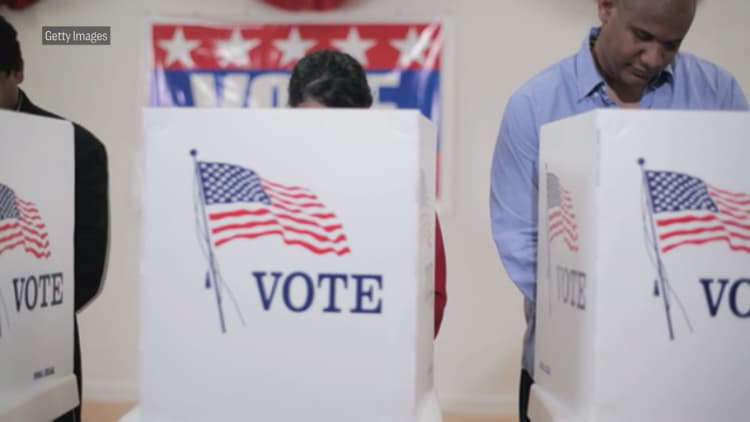
Billionaire venture capitalist Tim Draper's initiative that seeks to split California into three states has qualified for the November ballot but still faces hurdles to win a majority of votes.
Draper's plan would create a Northern California state that includes San Francisco, Silicon Valley and Sacramento, a Southern California state with San Diego, the Inland Empire counties and portions of the state's southern Central Valley. A third state would retain the name California and include Los Angeles, Santa Barbara and several other coastal counties.
Last month, the so-called Cal 3 campaign announced it delivered some 600,000 signatures, or nearly twice the amount required by law, to qualify for the Nov. 6 ballot. California Secretary of State Alex Padilla's office, which is in charge of validating the signatures, confirmed late Tuesday the backers had exceeded the required threshold and qualified.
"Californians deserve a more effective education system that isn't failing our families, more reliable infrastructure that isn't fracturing our communities, and more sensible taxes that aren't stifling our opportunities," Cal 3 says on its website.
"California's diverse regions require government attention that is specifically tailored to address that area's needs. Dividing California into smaller states will help elected officials decide which laws and tax regulations best suit that specific region, resulting in more responsive government," it added.
Congressional approval needed
Under the voter initiative, Los Angeles would anchor a new state named California and include five other counties. The state of Northern California would consist of 40 mostly rural counties and have its largest concentration of population in the San Francisco Bay area. The state of Southern California would include a dozen counties, including San Diego and Orange, as well as portions of the state's agricultural heartland — the San Joaquin Valley.
If approved by voters, the plan to split California would be subject to approval by Congress.
At the same time, proposals seek to create a "New California" as well as a so-called Calexit plan that asks voters whether California — the fifth-largest economy in the world — should become an independent country.
There have been more than 200 attempts throughout California's history to split up the state.
Draper proposed the three Californias measure in October after his previous initiative attempt in 2016 that sought to divide California into six states failed. The earlier attempt cost Draper more than $5 million.
Proponents want 'three fresh' starts
Proponents of the three Californias measure say the state government has become too beholden to special interest groups and unions and needs a fresh start. They also suggest it would function more efficiently broken into three parts.
"This is a chance for three fresh approaches to government," Draper told the San Francisco Chronicle in April. "Three new states could become models not only for the rest of the country, but for the whole world."
A poll released April 24 by Survey USA found 72 percent of voters are opposed to California splitting into three states.
Opponents of splitting up California say it would do more harm and cause greater disparity for residents.
"This measure would cost taxpayers billions of dollars to pay for the massive transactional costs of breaking up the state, whether it be universities, parks, or retirement systems," Steve Maviglio, a spokesman for the opposition group OneCalifornia said via Twitter.
"California government can do a better job addressing the real issues facing the state, but this measure is a massive distraction that will cause political chaos and greater inequality. Splitting California into three new states will triple the amount of special interests, lobbyists, politicians and bureaucracy," he added.
Major business group against split
Last month, the California Chamber of Commerce's board voted to oppose the measure.
"Rather than seeking to solve the very real problems before California, this measure would instead create an entirely new suite of problems to distract and consumer voters, political leaders, concerned citizens and ordinary residents," the chamber said last month in opposing the three Californias measure.
If voters approve the measure, congressional approval would be required as well as action by the state legislature to split up the state's assets and liabilities. If the legislature doesn't agree on a plan, the debts of California would get divided up based on population and assets determined by the new state borders.
Meantime, the Calexit measure from a group known as Yes California is gathering signatures needed to quality for the ballot in California and would result in state splitting from the United States. A similar effort failed last year.
Some argue that California already has essentially acted like a separate country by signing agreements, or memorandums of understanding, with nations on issues as well as climate change. The last time a state left the union was during the Civil War.
Calexit still gathering signatures
Proponents of Calexit were given the nod in April by the California's secretary of State to start gathering signatures to qualify for the ballot. If Calexit gets enough signatures, it would result in a special election in 2021 to ask California voters whether the state should become an independent country. The backers have until mid-October to gather almost 366,000 signatures of registered voters to qualify it.
Secession is seen as a long shot. A Berkeley IGS Poll released in March 2017 found Californians oppose independence from the U.S. by more than 2-1.
Another proposal, "New California," seeks to carve out rural counties into the 51st state. But this isn't a ballot initiative. The group is lining up support in counties and then hopes to take it to the legislature and then Congress.
The "New California" group is critical of California's so-called sanctuary state laws that seek to protect undocumented immigrants. Backers of the effort also are critical of what they consider the state's over-regulation.


